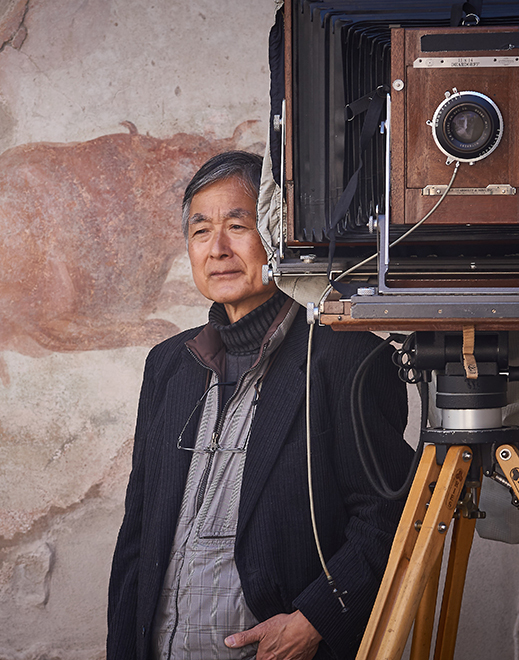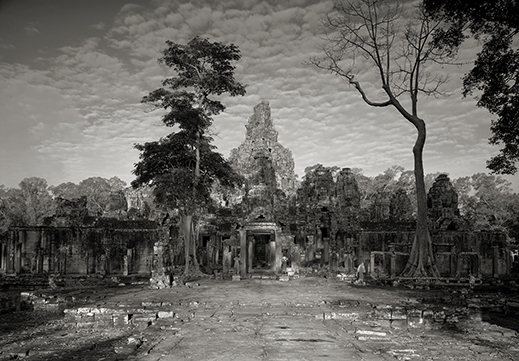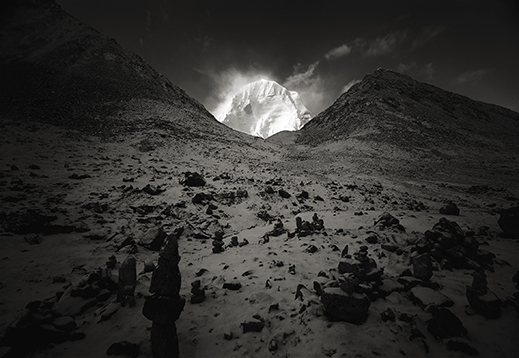| |
|
Here and There introduces art, artists, galleries, museums, and other cultural facilities around Japan that non-Japanese readers and first-time visitors may find of particular interest.
|
|
 |
|
|
 |
 |
The Colors of Monochrome: Kenro Izu at the Hanzomon Museum
Alan Gleason |
 |
Borobudur #15, Indonesia, 1996, © Kenro Izu. "The fog shrouding the jungle fades in the first rays of the morning sun to reveal the graceful form of a distant mountain in the direction of Buddha's gaze." |
Born in Osaka and schooled in photography in Tokyo, Kenro Izu emigrated to the United States in his early twenties and established himself as a commercial photographer in New York. But he didn't find his true calling, he says, until he visited the pyramids in Egypt. Since then he has devoted his career to photographing places of spiritual power across the planet -- notably in India, Nepal, Tibet, Cambodia, Laos, Thailand, and Indonesia -- seeking, he says, "that drop of shining essence that will someday emerge out of the coming together of serene observation and clear recording." Today he carries on that quest in Kanazawa, having returned to his homeland last year after fifty years in New York. Currently he is working on a project of photographing Noh masks, which have an uncanny spiritual aura of their own.
|
 |
|
|
|
Kenro Izu with his ultra-large format Deardorff camera.
|
Early on Izu became enamored of platinum printing, a photographic process that predates the daguerreotype but has only recently enjoyed a revival among artistic photographers who favor the sublimely subtle gradations of gray tones it affords. Izu is devoted to monochrome photography, but the term doesn't do justice to the beauty of his work -- all in shades of gray so rich and delicate as to render color extraneous.
A selection of 50 of Izu's platinum prints is on display at the Hanzomon Museum in downtown Tokyo until 22 May. The exhibition, Sacred Places of Asia, focuses on photographs he took during his extensive travels through South and Southeast Asia
between 1993 and 2012. Izu's drive to capture sacred mountains, monuments, and sanctuaries in some of the most isolated places on Earth has taken him to some remarkable locations, from Angkor Wat and Borobudur to Ladakh, Mt. Kailash, and the headwaters of the Ganges.
 |
|
Angkor #79, Bayon, Cambodia, 1994, © Kenro Izu. "In the moment that the Bayon temple is covered by a mysteriously pure light shining through the trees, the clouds cover the entire sky, creating an ethereal scene that fills me with profound inspiration." |
What makes these treks especially impressive is that they entail lugging (with the help of a couple of assistants) some 130 kilograms of equipment. Most of that weight consists of his prize possession, a massive, custom-made Deardorff camera capable of producing 14 x 20 inch negatives that don't require enlargement. The sheer physical exertion of hauling this camera on foot -- sometimes to altitudes as high as 5,000 meters -- is, he acknowledges, a kind of spiritual discipline in itself.
Angkor #26, Ta Prohm, Cambodia, 1993, © Kenro Izu. "When I encountered this tree, standing upon the temple with such authority, I was filled with thoughts that surpassed such mundane notions as life or death." |
The images in the Hanzomon show demonstrate why he feels the effort is worthwhile. A solitary Buddha figure greets the dawn at Borobudur. The massive roots of a tree, coursing with palpable life force, grip the ruins of a temple at Angkor Wat. An old temple in Varanasi teeters precariously on the riverbank as if it might slide into the Ganges at any moment. Countless stupas and pagodas stand sentinel on the plain of Pagan in Myanmar, stretching to the horizon where a hazy sun is setting. Hundreds of tiny Buddha statues fill a cave at Pak Ou in Laos, silhouetted against the white waters of the Mekong River; Izu had to wait for the midday sun to illuminate the cavern, then expose the film for several hours.
Varanasi #105, India, 1997, © Kenro Izu. "That evening, I stood by an abandoned Hindu temple that leaned out over the river while I waited for the sun to set." |
Though all these works are monochromatic, Izu does not go for the dramatically grainy light-dark contrasts typically associated with postwar Japanese black-and-white photography. The landscapes seem swathed in a soft gray gauze, yet their resolution is stunning -- delighting the eye with the finest details, and without the sharp in-your-face quality of digital prints. Izu speaks of waiting patiently for the right instant to press the shutter, and often that instant comes just after sunrise or before sunset. In a shot of the Lamayuru gompa in Ladakh, the monastery gleams in the late afternoon sun as the surrounding peaks and valleys fall into shadow. And in vivid testimonial to platinum printing's capacity for high contrast, the north face of western Tibet's sacred Mt. Kailash glistens like a diamond in the first light of dawn.
 |
|
Kailash #75, Tibet, China, 2000, © Kenro Izu. "As the first rays of the sun touched the 6,656-meter peak, the fresh snow was picked up in a gust of wind, wrapping the sacred mountain in a white veil." |
There are no human subjects in this selection of photos, yet the scenes feel warm and inviting. For one thing, the many Buddhist figures appearing in them exude an organic vitality. (Izu does photograph people extensively; for a look at some moving portraits from his Eternal Light series, taken in India between 2010 and 2015, see this review of a 2016 Izu show in Here and There.)
The Hanzomon Museum's permanent exhibition of Buddhist statuary and artwork. |
The prominence of Buddhist sites and statuary in these works reflects not only Izu's interests but also those of the museum, which is run by the Buddhist organization Shinnyo-en. The venue is, in fact, a perfect match for the show, which shares space with the museum's exquisite collection of Buddhist artwork. Among its treasures are a set of small stone reliefs, created in Gandhara in the 2nd or 3rd century, that depict episodes in the life of the Buddha; two massive mandalas of the Two Realms (Diamond and Womb), painted by the monk Kakusen in 1706; and a beautiful black wooden statue of a seated Acalanatha (Fudo Myo-o), the fierce, delusion-smiting Wisdom King. Pride of place, however, goes to a 12th-century sculpture of a seated Mahavairocana (Dainichi Nyorai), the Sun Buddha worshiped in Esoteric Buddhism. Attributed to the legendary sculptor Unkei, it is designated an Important Cultural Property.
|
 |
|
|
|
Seated Mahavairocana (Dainichi Nyorai), Kamakura period (12th century) ca. 1193, attributed to Unkei; wood with gold leaf and pigment, inlaid crystal eyes. Important Cultural Property
|
The museum's theater offers three videos (with English translation available) about the Unkei statue, the Gandhara reliefs, and the mandalas. Additionally, the Izu exhibition is accompanied by an hour-long series of short videos about the photographer and his work; one highlight is the spectacular footage of some of his mountain treks. All of these presentations are well worth seeing -- note, however, that the Izu videos are in Japanese only.
All photographic works by Kenro Izu; all images courtesy of the Hanzomon Museum.
|
|
|
| |
 |
Alan Gleason
Alan Gleason is a translator, editor and writer based in Tokyo, where he has lived for over 30 years. Since 2006 he has edited artscape Japan and written the Here and There column, as well as translating the Picks reviews. He also edits and translates works on Japanese architecture, music, and theater. |
|
|
|
|
|
|
|
|
|
 |
|